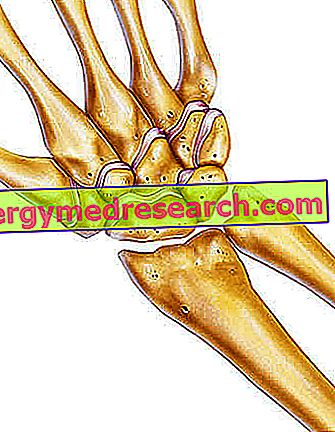Generality
Pulse is a term that, in human anatomy, can have at least three different meanings:
- may indicate the joint resulting from the interaction between the distal end of the radius and the scaphoid and semilunar carpal bones;
- it can be synonymous with carpus, that is the proximal portion of the skeleton of the hand including other 6 bones, in addition to the scaphoid and the lunate;
- finally, it can refer to the extensive region of the human body which includes the distal end of radius and ulna, the 8 carpal bones and the bases of the 5 metacarpal bones.
What is the pulse?
The wrist is the even region of the human body, which marks the end of the forearm and the beginning of the hand .
In human anatomy, the term "wrist" can indicate:
- The articulation of the wrist, resulting from the interaction between the distal end of the radius and the carpus of the hand ;
- The group of 8 bones making up the carpus of the hand, also known as carpal bones ;
- The extensive region of the human body which includes the distal end of radius and ulna, the 8 carpal bones and the bases of the 5 metacarpal bones (or metacarpals ).
This article refers to the wrist with the meaning of wrist joint.
Review of the meaning of the terms proximal and distal
Proximal and distal are two terms with opposite meaning.
Proximal means "closer to the center of the body" or "closer to the point of origin". Referring to the femur, for example, it indicates the portion of this bone closest to the trunk.
Distal, on the other hand, means "farther from the center of the body" or "farther from the point of origin". Referred (always to the femur), for example, it indicates the portion of this bone furthest from the trunk (and closer to the trunk). 'knee joint).
REVIEW OF WHAT IS A ARTICULATION

According to the most common anatomical view, there would be three main categories of joints:
- Fibrous joints (or synarthrosis ). They generally lack mobility and the constituent bones are held together by fibrous tissue. Typical examples of synarthrosis are the joints between the bones of the skull.
- Cartilaginous joints (or amphiarthrosis ). They have poor mobility and the constituent bones are joined by cartilage. Classic examples of amphiarthrosis are the joints that connect the vertebrae of the spine.
- Synovial joints (or diarthrosis ). They are highly mobile and include various components, including: the articular surfaces and the cartilage that covers them, the joint capsule, the synovial membrane, the synovial bags and a series of ligaments and tendons.
Typical examples of diarthrosis are the joints of the shoulder, knee, hip and ankle.
Anatomy
The wrist is a synovial joint that sees the scaphoid and semilunar carpus bones interact with the two facet joints of the distal end of the radius.
CARPO AND BONES CARPALS THAT FORM THE WRIST
The carpus is the set of 8 irregular bones that constitutes the proximal portion of the skeleton of the hand.
Including between the metacarpals (intermediate portion of the skeleton of the hand) and the bones of the forearm, the 8 bone elements of the carpus - the so-called carpal bones - are arranged equally on two rows: one row is close to radius and ulna, and takes the proximal row name; the other row, instead, is close to the 5 metacarpal bones and is known as the distal row .
The scaphoid and the lunate - ie the two carpal bones that form the wrist joint - belong to the proximal row, together with the carpal bifurcate and the pisiform carpal bone.
These last ones, together with the carpal bones of the distal trapezium row, are to be kept in mind, for when the chapter dedicated to the ligaments of the wrist joint will be addressed .

Figure: the 27 bones of the human hand.
The 8 carpal bones are added to the already mentioned 5 metacarpals and to the 14 phalanges of the fingers, which constitute the distal portion of the skeleton of the hand, as well as the terminal extremity of the upper limbs.
If the 4 bony elements that form the proximal row of the carpal bones are the scaphoid, the lunate, the triquatum and the pisiform, the 4 bony elements that make up the distal row of the carpal bones are the so-called trapezoid, trapezoid, capitate and hooked .
| Carpus bones: | |
Proximal row, that is the row closest to the radius | scaphoid lunate triquetrum pisiform |
Distal row, ie the row closest to the metacarpal bones | Keystone trapezoid happened uncinato |
RADIO AND DISTAL END OF THE RADIO
Radium is the bone that, together with the ulna, forms the skeleton of the forearm. It belongs to the category of long bones, or bones in which three characteristic portions are recognizable, known as: proximal end (or proximal epiphysis ), body (or diaphysis ) and distal end (or distal epiphysis ).
The proximal end of the radius is the portion of bone closest to the arm and which, joining the humerus (arm bone), gives life to the important articulation of the elbow .
The body of the radium is the central bone portion, between the proximal end and the distal end; of cylindrical shape, inside it contains the bone marrow .
Finally, the distal end of the radius is the portion of bone closest to the hand and which borders on the bones of the carpus.
In the anatomy of the distal end of the radius, the facet joints are the two slightly concave surfaces, smooth in appearance and separated by a small ridge, which look in the direction of the carpus and have the task of joining, with the help of a fibrocartilaginous structure called articular disc, at the scaphoid and at the lunate.
To distinguish the two facet joints from each other, the anatomists considered it appropriate to indicate them with two terms that referred to their location; the terms in question are " lateral " and " medial ". Triangular in shape, the lateral articular facet is the surface responsible for relating to the scaphoid; on the other hand, the medial articular facet is the surface that is responsible for the joint with the lunate.

WRIST TIES
A ligament is a band of fibrous connective tissue, which connects multiple bones or different parts of the same bone.
The wrist joint includes a number of ligaments. These ligaments serve to give stability to the relationship between the two scaphoid and semilunar carpal bones and the distal end of the radius, during hand movements; giving stability means that they contain joint mobility, so as to preserve the bone surfaces that are in contact with each other.
Going into more detail, the ligaments of the wrist joint are:
- The radial collateral ligament . It is a ligament with a head of origin and two terminal heads. The original head is attached to the styloid process present on the distal end of the radius, while the two terminal ends are inserted one on the scaphoid and one on the trapeze.
Thus, the radial collateral ligament runs from the styloid process of the distal end of the radius to the scaphoid and trapezius carpal bones.
- The ulnar collateral ligament . It is a ligament structurally very similar to the radial collateral ligament, therefore with a head of origin and two terminal ends.
The head of origin finds insertion on the so-called styloid process present on the distal end of the ulna, while the two end heads hook one to the triqueter and one to the pisiform.
Therefore, the ulnar collateral ligament runs from the styloid process of the distal extremity of the ulna to the three- and pisiform carpal bones.
- The palmar radiocarpal ligament . It is a ligament that originates at the distal end of the radius and ends up in different bones of the carpus, to be precise: scaphoid, triquetrum, lunate and, sometimes, happened.
- The dorsal radiocarpal ligament . It is a ligament that originates at the distal end of the radius and ends at the scaphoid, semilunar and triquared carpal bones.
Functions
The wrist is a fundamental articulation for the functionality of the hand. In fact, its movements include:
- Hand bending . It is the movement that allows you to bring the palm of your hand closer to your arm. Imagining to observe an upper limb completely extended forward, the flexion of the wrist is the movement that bends the hand downwards.
- Hand extension . It is the movement that allows the back of the hand to be brought closer to the arm. Imagining to observe an upper limb completely extended forward, the extension of the wrist is the movement that bends the hand upwards.
- Radial deviation of the hand . It is the movement that allows the side of the hand to be brought closer with the thumb to the radio.
- Ulnar deviation of the hand . It is the movement that allows the side of the hand to be approached with the little finger to the ulna.
- Hand surround . It is the rotation movement of the hand.
clinic
The wrist joint can be the victim of bone fractures, sprains of the ligaments and the two most common forms of arthritis, namely osteoarthritis (or arthrosis ) and rheumatoid arthritis .
Readers are reminded that, in medicine, the term arthritis refers to any inflammatory process involving one or more joints of the body.
Fractures, sprains and arthritis of the wrist have one symptom in common: pain .
An in-depth description of wrist pain (from its main causes to therapy) is present here.
FRACTURES AND DISTORTIONS OF THE WRIST
Fractures and sprains against the wrist joint are injuries that generally have a traumatic origin, that is, they appear following a trauma.
In fact, one of their main causes is the violent impact of the hands with the ground, after an accidental fall.
As regards only wrist fractures, it is important to point out that, in a limited number of cases, the cause is the continuous repetition of a certain hand movement. In such circumstances, the resulting fractures are more properly called stress fractures .
In general, stress fractures are less serious than traumatic fractures.
The bone of the wrist joint most prone to fractures, after a violent impact with the ground, is the scaphoid.
OSTEOARTRITE AND RHEUMATOID ARTHRITIS
In osteoarthritis, the characteristic inflammatory process derives from the deterioration of the articular cartilage, that is the layer of cartilage that covers the surfaces of the bones involved in the formation of a joint .
In rheumatoid arthritis, on the other hand, inflammation is a consequence of the degeneration of the synovial membrane of a joint, a degeneration on which a series of successive alterations depends, affecting the articular cartilage and the articular ligaments.
The wrist is generally more prone to rheumatoid arthritis than to osteoarthritis.


